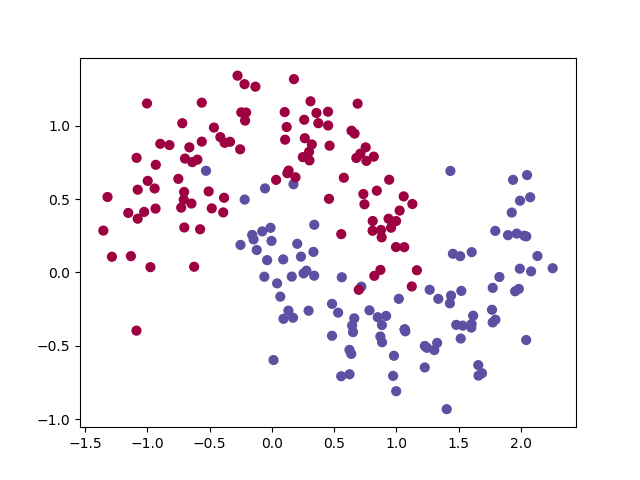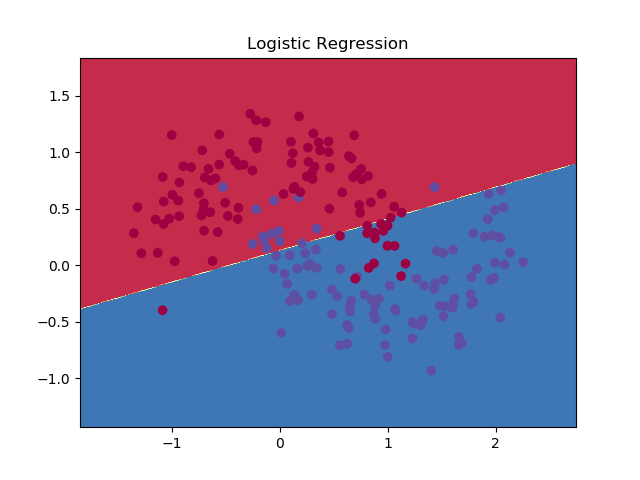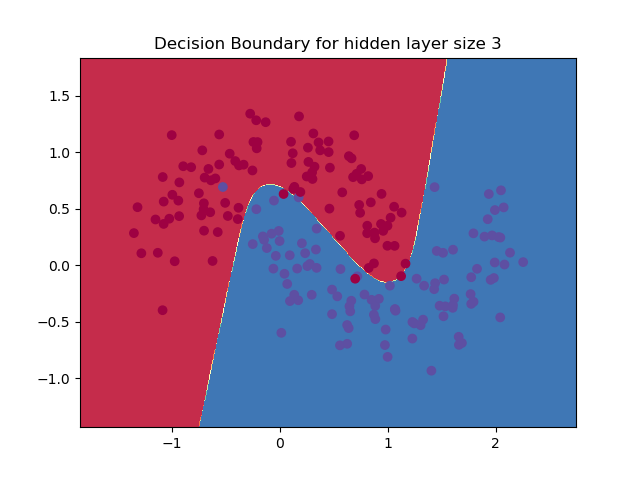深層学習の学習 【その3】[追記]
[追記]
便利参考サイトを追記しました
概要
以前は下記記事のようにTensorflowで深層学習について学ぶ予定でしたが、やはり基礎も抑えておかないと応用するときに立ち往生すると思うので、少し違ったアプローチで学習します。
【記事1】
kuroyagi.hatenablog.com
今回は以下をやってみます。
【記事2】
qiita.com
そこそこpythonの心得がないと例のサンプルコードが実行出来ません。いろいろといらべて動くようになったので、その点を補った手順を示します。ちなみに、【記事3】も併せて見ると基本的なところまでカバーできると思います。
【記事3】
qiita.com
実践
【記事2】の内容を噛み砕いて進めていきます。ちなみに環境は以下の通りです。
OS: windows7 64bit
Python: 3.6.1
1.準備
仮想環境として今回はDeepというフォルダを作りました。方法は以下の通り
py -3 -m venv Deep
今回必要なパッケージは以下の通り
・matplotlib
・numpy
・scipy
・sklearn
・chainer
以上をpipを使って仮想環境にインストールしておきましょう。尚、numpy、scipyはインストール方法が特殊なので以下の【記事4】にあるその他ライブラリの項目を参考にしてインストールして下さい。
【記事4】
kuroyagi.hatenablog.com
2.データの生成と描画
【記事2】に倣って先ずは解析するデータを生成します以下の【ソースコード1】で動くはずです。
【ソースコード1】
import numpy as np import sklearn.datasets import matplotlib import matplotlib.pyplot as plt np.random.seed(0) X,y=sklearn.datasets.make_moons(200,noise=0.20) plt.scatter(X[:,0], X[:,1], s=40, c=y, cmap=plt.cm.Spectral) plt.show()
結果はこんな感じです。
【画像1】

3.ロジスティクス回帰モデル
お次はロジスティクス回帰モデルを学習させます。
【ソースコード2】
import numpy as np import sklearn.datasets import sklearn.linear_model import matplotlib import matplotlib.pyplot as plt np.random.seed(0) X,y=sklearn.datasets.make_moons(200,noise=0.20) plt.scatter(X[:,0], X[:,1], s=40, c=y, cmap=plt.cm.Spectral) # ロジスティック回帰モデルを学習させる clf = sklearn.linear_model.LogisticRegressionCV() clf.fit(X, y) def plot_decision_boundary(pred_func): # Set min and max values and give it some padding x_min, x_max = X[:, 0].min() - .5, X[:, 0].max() + .5 y_min, y_max = X[:, 1].min() - .5, X[:, 1].max() + .5 h = 0.01 # Generate a grid of points with distance h between them xx, yy = np.meshgrid(np.arange(x_min, x_max, h), np.arange(y_min, y_max, h)) # Predict the function value for the whole gid Z = pred_func(np.c_[xx.ravel(), yy.ravel()]) Z = Z.reshape(xx.shape) # Plot the contour and training examples plt.contourf(xx, yy, Z, cmap=plt.cm.Spectral) plt.scatter(X[:, 0], X[:, 1], c=y, cmap=plt.cm.Spectral) # 決定境界をプロットする plot_decision_boundary(lambda x: clf.predict(x)) plt.title("Logistic Regression") plt.show()
結果はこんな感じです。
【画像2】

注意点
・plot_decision_boundaryは標準関数ではないからソースコード内で定義
4.ニューラルネットワーク
【ソースコード3】
import numpy as np import sklearn.datasets import sklearn.linear_model import matplotlib import matplotlib.pyplot as plt np.random.seed(0) X,y=sklearn.datasets.make_moons(200,noise=0.20) plt.scatter(X[:,0], X[:,1], s=40, c=y, cmap=plt.cm.Spectral) # ロジスティック回帰モデルを学習させる clf = sklearn.linear_model.LogisticRegressionCV() clf.fit(X, y) def plot_decision_boundary(pred_func): # Set min and max values and give it some padding x_min, x_max = X[:, 0].min() - .5, X[:, 0].max() + .5 y_min, y_max = X[:, 1].min() - .5, X[:, 1].max() + .5 h = 0.01 # Generate a grid of points with distance h between them xx, yy = np.meshgrid(np.arange(x_min, x_max, h), np.arange(y_min, y_max, h)) # Predict the function value for the whole gid Z = pred_func(np.c_[xx.ravel(), yy.ravel()]) Z = Z.reshape(xx.shape) # Plot the contour and training examples plt.contourf(xx, yy, Z, cmap=plt.cm.Spectral) plt.scatter(X[:, 0], X[:, 1], c=y, cmap=plt.cm.Spectral) # 決定境界をプロットする plot_decision_boundary(lambda x: clf.predict(x)) plt.title("Logistic Regression") num_examples = len(X) # 学習用データサイズ nn_input_dim = 2 # インプット層の次元数 nn_output_dim = 2 # アウトプット層の次元数 # Gradient descent parameters (数値は一般的に使われる値を採用) epsilon = 0.01 # gradient descentの学習率 reg_lambda = 0.01 # regularizationの強さ # 全Lossを計算するためのHelper function def calculate_loss(model): W1, b1, W2, b2 = model['W1'], model['b1'], model['W2'], model['b2'] # 予測を算出するためのForward propagation z1 = X.dot(W1) + b1 a1 = np.tanh(z1) z2 = a1.dot(W2) + b2 exp_scores = np.exp(z2) probs = exp_scores / np.sum(exp_scores, axis=1, keepdims=True) # Lossを計算 corect_logprobs = -np.log(probs[range(num_examples), y]) data_loss = np.sum(corect_logprobs) # Lossにregulatization termを与える (optional) data_loss += reg_lambda/2 * (np.sum(np.square(W1)) + np.sum(np.square(W2))) return 1./num_examples * data_loss # Helper function to predict an output (0 or 1) def predict(model, x): W1, b1, W2, b2 = model['W1'], model['b1'], model['W2'], model['b2'] # Forward propagation z1 = x.dot(W1) + b1 a1 = np.tanh(z1) z2 = a1.dot(W2) + b2 exp_scores = np.exp(z2) probs = exp_scores / np.sum(exp_scores, axis=1, keepdims=True) return np.argmax(probs, axis=1) # This function learns parameters for the neural network and returns the model. # - nn_hdim: Number of nodes in the hidden layer # - num_passes: Number of passes through the training data for gradient descent # - print_loss: If True, print the loss every 1000 iterations def build_model(nn_hdim, num_passes=20000, print_loss=False): # Initialize the parameters to random values. We need to learn these. np.random.seed(0) W1 = np.random.randn(nn_input_dim, nn_hdim) / np.sqrt(nn_input_dim) b1 = np.zeros((1, nn_hdim)) W2 = np.random.randn(nn_hdim, nn_output_dim) / np.sqrt(nn_hdim) b2 = np.zeros((1, nn_output_dim)) # This is what we return at the end model = {} # Gradient descent. For each batch... for i in range(0, num_passes): # Forward propagation z1 = X.dot(W1) + b1 a1 = np.tanh(z1) z2 = a1.dot(W2) + b2 exp_scores = np.exp(z2) probs = exp_scores / np.sum(exp_scores, axis=1, keepdims=True) # Backpropagation delta3 = probs delta3[range(num_examples), y] -= 1 dW2 = (a1.T).dot(delta3) db2 = np.sum(delta3, axis=0, keepdims=True) delta2 = delta3.dot(W2.T) * (1 - np.power(a1, 2)) dW1 = np.dot(X.T, delta2) db1 = np.sum(delta2, axis=0) # Add regularization terms (b1 and b2 don't have regularization terms) dW2 += reg_lambda * W2 dW1 += reg_lambda * W1 # Gradient descent parameter update W1 += -epsilon * dW1 b1 += -epsilon * db1 W2 += -epsilon * dW2 b2 += -epsilon * db2 # Assign new parameters to the model model = { 'W1': W1, 'b1': b1, 'W2': W2, 'b2': b2} # Optionally print the loss. # This is expensive because it uses the whole dataset, so we don't want to do it too often. if print_loss and i % 1000 == 0: print ("Loss after iteration %i: %f" %(i, calculate_loss(model))) return model # 3次元の隠れ層を持つモデルを構築 model = build_model(3, print_loss=True) # 決定境界をプロットする plot_decision_boundary(lambda x: predict(model, x)) plt.title("Decision Boundary for hidden layer size 3") plt.show()
結果は以下の通り。
Loss after iteration 0: 0.432387 Loss after iteration 1000: 0.068947 Loss after iteration 2000: 0.068890 Loss after iteration 3000: 0.071218 Loss after iteration 4000: 0.071253 Loss after iteration 5000: 0.071278 Loss after iteration 6000: 0.071293 Loss after iteration 7000: 0.071303 Loss after iteration 8000: 0.071308 Loss after iteration 9000: 0.071312 Loss after iteration 10000: 0.071314 Loss after iteration 11000: 0.071315 Loss after iteration 12000: 0.071315 Loss after iteration 13000: 0.071316 Loss after iteration 14000: 0.071316 Loss after iteration 15000: 0.071316 Loss after iteration 16000: 0.071316 Loss after iteration 17000: 0.071316 Loss after iteration 18000: 0.071316 Loss after iteration 19000: 0.071316
【画像3】

注意点
・python3系ではxrangeが削除されているのでxrange=>rangeに修正
まとめ
何とかできました!
内容は薄っすらしか分かりませんが、何回か読み直しつつソースコードを眺めつつ復習したいと思います。
以下過去記事です。
深層学習の学習【その1】[追記] - Kuroyagi飼育日誌
深層学習の学習【その2】[追記] - Kuroyagi飼育日誌